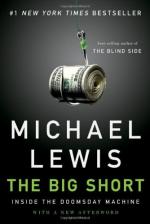
|
| Name: _________________________ | Period: ___________________ |
This test consists of 15 multiple choice questions and 5 short answer questions.
Multiple Choice Questions
1. The top bond traders of the 1980s called themselves by what nickname, becoming inspiration for the books The Bonfire of the Vanities and Liar's Poker?
(a) "Men in Black".
(b) "Wall Street Men".
(c) "The Doctor Zivagos".
(d) "Big Swinging Dicks".
2. Asperger's syndrome differs from other autistic disorders by its relative preservation of development in what areas?
(a) Linguistic and cognitive.
(b) Coordination and Linguistic.
(c) Linguistic.
(d) Cognitive and spacial.
3. What is the central banking system of the United States?
(a) U.S. Bank.
(b) The World Bank.
(c) The Federal Reserve.
(d) Wells Fargo.
4. What is the title of Chapter 6?
(a) Wall Street Bigshot.
(b) Accidental Capitalists.
(c) Spider-Man at The Venetian.
(d) How to Harvest a Migrant Worker.
5. What does the SEC refer to?
(a) Sellers and Engineers Committee.
(b) Special Experts Conglomerate.
(c) Speculators and Experts Council.
(d) Securities and Exchange Commission.
6. In Chapter 6, Eisman realized that the CDO manager sitting next to him was selling CDOs that were synthesized from what?
(a) CDSs.
(b) Other synthesized CDOs.
(c) ISDAs.
(d) Tranches.
7. The first night of the conference in Chapter 6, Steve Eisman was seated next to a man who was a CDO manager for what company?
(a) Merrill Lynch.
(b) Cornwall Capital Management.
(c) Standard & Poor's.
(d) FrontPoint.
8. What is the title of Chapter 8?
(a) The Long Quiet.
(b) Wall Street.
(c) Two Men in a Boat.
(d) Bonds and CEOs.
9. When was the conference for subprime mortgage bond salesmen and buyers in Chapter 6?
(a) May, 2008.
(b) June, 2004.
(c) August, 2008.
(d) January, 2007.
10. What is the title of Chapter 7?
(a) The Gold Rush.
(b) The Great Treasure Hunt.
(c) Gathering Eggs.
(d) Money Wonders.
11. When did FrontPoint close its health fund in amid accusations of insider trading and an FBI probe?
(a) 2006.
(b) 2005.
(c) 2008.
(d) 2010.
12. In Chapter 7, Eisman not only bought the CDOs offered by Lippmann, but he also began to short who?
(a) The London banks involved with the bonds.
(b) The SEC.
(c) The Federal Reserve.
(d) The Wall Street banks involved in these bonds.
13. Salomon Brothers is now a subsidiary of what company?
(a) Bear Sterns.
(b) U.S. Bank.
(c) Citigroup.
(d) Wachovia.
14. Who is the 29th chairperson of the SEC?
(a) Mary Schapiro.
(b) Gerald Robinson.
(c) William H. Donaldson.
(d) Christopher Cox.
15. What was the profession of Michael Lewis' father?
(a) Doctor.
(b) Corporate lawyer.
(c) Electrician.
(d) Plumber.
Short Answer Questions
1. In his Epilogue, what does the author amount to billion dollar gifts paid for by the American people?
2. Who began shorting the stocks of rating companies as well as many of the CDO managers in Chapter 6?
3. The SEC was established by the United States Congress in what year?
4. In the Epilogue, Michael Lewis tells his readers about a lunch meeting he had with his former CEO at what company?
5. After the conference in Chapters 6 and 7, who began buying millions of CDOs, anxious to buy as many as they could before it was too late?
|
This section contains 473 words (approx. 2 pages at 300 words per page) |

|




